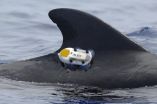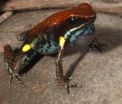(Press-News.org) BOSTON –– Scientists say they have identified in about 20 percent of colorectal and endometrial cancers a genetic mutation that had been overlooked in recent large, comprehensive gene searches. With this discovery, the altered gene, called RNF43, now ranks as one of the most common mutations in the two cancer types.
Reporting in the October 26, 2014 edition of Nature Genetics, investigators from Dana-Farber Cancer Institute and the Broad Institute of MIT and Harvard said the mutated gene helps control an important cell-signaling pathway, Wnt, that has been implicated in many forms of cancer. They suggest that the RNF43 mutation may serve as a biomarker that identifies patients with colorectal and endometrial cancer who could benefit from precision cancer drugs that target the Wnt pathway, although no such drugs are currently available.
"Tumors that have this mutation may be telling us that they are dependent on the Wnt signaling pathway, and they will be uniquely sensitive to drugs that inhibit this pathway," said Charles Fuchs, MD, MPH, an author of the paper and director of the Center for Gastrointestinal Cancer at Dana-Farber. He is also affiliated with Brigham and Women's Hospital and the Harvard School of Public Health.
In animal models of cancer, tumors that harbor RNF43 mutations have been found to be sensitive to new Wnt pathway inhibitors that are now in clinical trials in humans, according to Marios Giannakis, MD, PhD, who is affiliated with Dana-Farber and is also a postdoctoral researcher at the Broad Institute.
The researchers were surprised to find RNF43 mutations in such a significant proportion of colorectal and endometrial cancers because they had not been detected in recent comprehensive searches of tumor DNA conducted by scientists of The Cancer Genome Atlas (TGCA) project.
Authors of the new study believe computer algorithms used by TCGA to parse data from DNA sequencing of tumors may have interpreted the "signal" of the RNF45 mutation as an artifact, and discarded it, much as a legitimate email will sometimes be trapped in a junk filter.
"These mutations occur in repetitive regions of the genome where you often have errors in DNA sequencing, so the algorithm may have been more likely to assume that the RNF43 mutation was an artifact of the sequencing process," explained Eran Hodis, an MD/PhD student at Harvard Medical School and MIT and also affiliated with the Broad and Dana-Farber. Giannakis and Hodis are co-first authors on the new report.
Other frequently mutated genes in colorectal cancer include APC (73 percent), P53 (50 percent), and KRAS (40 percent).
The new evidence for RNF45 mutations first came from analysis of tumor samples of colorectal cancer that were obtained from two large cohort studies – the Nurses' Health Study, which has been following 121,000 healthy women since 1976, and the Health Professionals Follow-up Study, which includes 52,000 men enrolled in 1986. About 10 years ago, Fuchs, along with Dana-Farber pathologist Shugi Ogino, MD, PhD, MS, began collecting and studying gastrointestinal tumor samples that had been taken from men and women in the studies who developed cancer. Because these specimens are accompanied by a wealth of data about the patients' lifestyle, medical history, and other factors, Fuchs calls this collection of tumor samples "a gold mine."
For the new study, 185 colorectal cancer specimens from this collection were analyzed by whole-exome DNA sequencing at the Broad Institute under the leadership of Levi Garraway, MD, PhD, who is affiliated with Dana-Farber, the Broad, and Brigham and Women's Hospital, and is corresponding author of the report. The RNF43 mutation was identified in 18.9 percent of the colorectal tumors.
This surprising result prompted the investigators to re-analyze 222 colorectal cancer samples from TCGA project and found the RNF43 mutation in 17.6 percent. The researchers, noting that endometrial cancer is dependent on abnormal Wnt signaling, then re-analyzed 248 DNA samples from endometrial cancer that had been previously analyzed by TCGA scientist. They found a strikingly similar proportion – 18.1 percent – of RNF43 mutations in those cancers. The scientists predict they will find the mutation in stomach cancers as well, which also are driven by abnormal Wnt signaling.
The study authors noted that the discovery of such a significant cancer mutation that hadn't been picked up in the previous gene hunts shows that carrying out these comprehensive genomic searches continues to have value.
INFORMATION:
Important Points
Discovery shows comprehensive genomic searches continue to have value
Altered gene now ranks as one of the most common mutations in two cancer types
The National Institutes of Health provided research funding under grants U54HG003067, K07CA190673, P01 CA87969, UM1 CA167552, R01 CA151993, R01 CA118553, R01 CA168141, and P50 CA127003. The Paula and Russell Agrusa Fund for Colorectal Cancer Research, the 2014 Colon Cancer Alliance-AACR Fellowship for Biomarker Research, the Perry S. Levy Endowed Fellowship and the Herchel Smith Fellowship also supported and provided funding for this study.
About Dana-Farber Cancer Institute
Dana-Farber Cancer Institute, a principal teaching affiliate of Harvard Medical School, is world renowned for its leadership in adult and pediatric cancer treatment and research. Designated as a comprehensive cancer center by the National Cancer Institute (NCI), it is one of the largest recipients among independent hospitals of NCI and National Institutes of Health grant funding.
Why do we remember some things and not others? In a unique imaging study, two Northwestern University researchers have discovered how neurons in the brain might allow some experiences to be remembered while others are forgotten. It turns out, if you want to remember something about your environment, you better involve your dendrites.
Using a high-resolution, one-of-a-kind microscope, Daniel A. Dombeck and Mark E. J. Sheffield peered into the brain of a living animal and saw exactly what was happening in individual neurons called place cells as the animal navigated a virtual ...
Digoxin, a medication used in the treatment of heart failure, may be adaptable for the treatment of amyotrophic lateral sclerosis (ALS), a progressive, paralyzing disease, suggests new research at Washington University School of Medicine in St. Louis.
ALS, also known as Lou Gehrig's disease, destroys the nerve cells that control muscles. This leads to loss of mobility, difficulty breathing and swallowing and eventually death. Riluzole, the sole medication approved to treat the disease, has only marginal benefits in patients.
But in a new study conducted in cell cultures ...
CHAMPAIGN, Ill. — Researchers report in the journal Nature that they have made a breakthrough in understanding how a powerful antibiotic agent is made in nature. Their discovery solves a decades-old mystery, and opens up new avenues of research into thousands of similar molecules, many of which are likely to be medically useful.
The team focused on a class of compounds that includes dozens with antibiotic properties. The most famous of these is nisin, a natural product in milk that can be synthesized in the lab and is added to foods as a preservative. Nisin has ...
Most of the concerns about climate change have focused on the amount of greenhouse gases that have been released into the atmosphere.
But in a new study published in Science, a group of Rutgers researchers have found that circulation of the ocean plays an equally important role in regulating the earth's climate.
In their study, the researchers say the major cooling of Earth and continental ice build-up in the Northern Hemisphere 2.7 million years ago coincided with a shift in the circulation of the ocean – which pulls in heat and carbon dioxide in the Atlantic ...
DENVER – A better survival outcome is associated with low blood levels of squamous cell carcinoma antigen, or absence of tumor invasion either into the space between the lungs and chest wall or into blood vessels of individuals with a peripheral squamous cell carcinoma, a type of non-small cell lung cancer (NSCLC).
Lung cancer is the most common cause of cancer-related death worldwide and lung squamous cell carcinomas (SCC) account for 20-30% of all NSCLC. SCC can be classified as either central (c-SCC) or peripheral (p-SCC) depending on the primary location. While ...
VIDEO:
On Oct. 23, while North America was witnessing a partial eclipse of the sun, the Hinode spacecraft observed a 'ring of fire' or annular eclipse from its location hundreds of...
Click here for more information.
The moon passed between the Earth and the sun on Thursday, Oct. 23. While avid stargazers in North America looked up to watch the spectacle, the best vantage point was several hundred miles above the North Pole.
The Hinode spacecraft was in the right place at the ...
DURHAM, N.C. -- Many marine animals are world travelers, and scientists who study and track them can rarely predict through which nations' territorial waters their paths will lead.
In a new paper in the journal Marine Policy, Duke University Marine Lab researchers argue that coastal nations along these migratory routes do not have precedent under the law of the sea to require scientists to seek advance permission to remotely track tagged animals in territorial waters.
Requiring scientists to gain advance consent to track these animals' unpredictable movements is impossible, ...
DURHAM, N.C. – Frogs are well-known for being among the loudest amphibians, but new research indicates that the development of this trait followed another: bright coloration. Scientists have found that the telltale colors of some poisonous frog species established them as an unappetizing option for would-be predators before the frogs evolved their elaborate songs. As a result, these initial warning signals allowed different species to diversify their calls over time.
Zoologists at the National Evolutionary Synthesis Center (NESCent), the University of British Columbia, ...
NASA scientists have identified an unexpected high-altitude methane ice cloud on Saturn's moon Titan that is similar to exotic clouds found far above Earth's poles.
This lofty cloud, imaged by NASA's Cassini spacecraft, was part of the winter cap of condensation over Titan's north pole. Now, eight years after spotting this mysterious bit of atmospheric fluff, researchers have determined that it contains methane ice, which produces a much denser cloud than the ethane ice previously identified there.
"The idea that methane clouds could form this high on Titan is completely ...
In a study just published in the International Journal of Cardiology, researchers from the K.G. Jebsen Center for Exercise in Medicine – Cardiac Exercise Research Group (CERG) at the Norwegian University of Science and Technology (NTNU) and the Department of Cardiothoracic Surgery at the St. Olavs Hospital in Trondheim, Norway have shown that shutting off the blood supply to an arm or leg before cardiac surgery protects the heart during the operation.
The research group wanted to see how the muscle of the left chamber of the heart was affected by a technique, called ...






